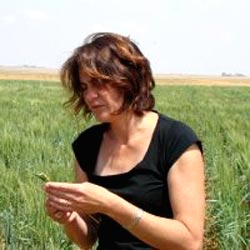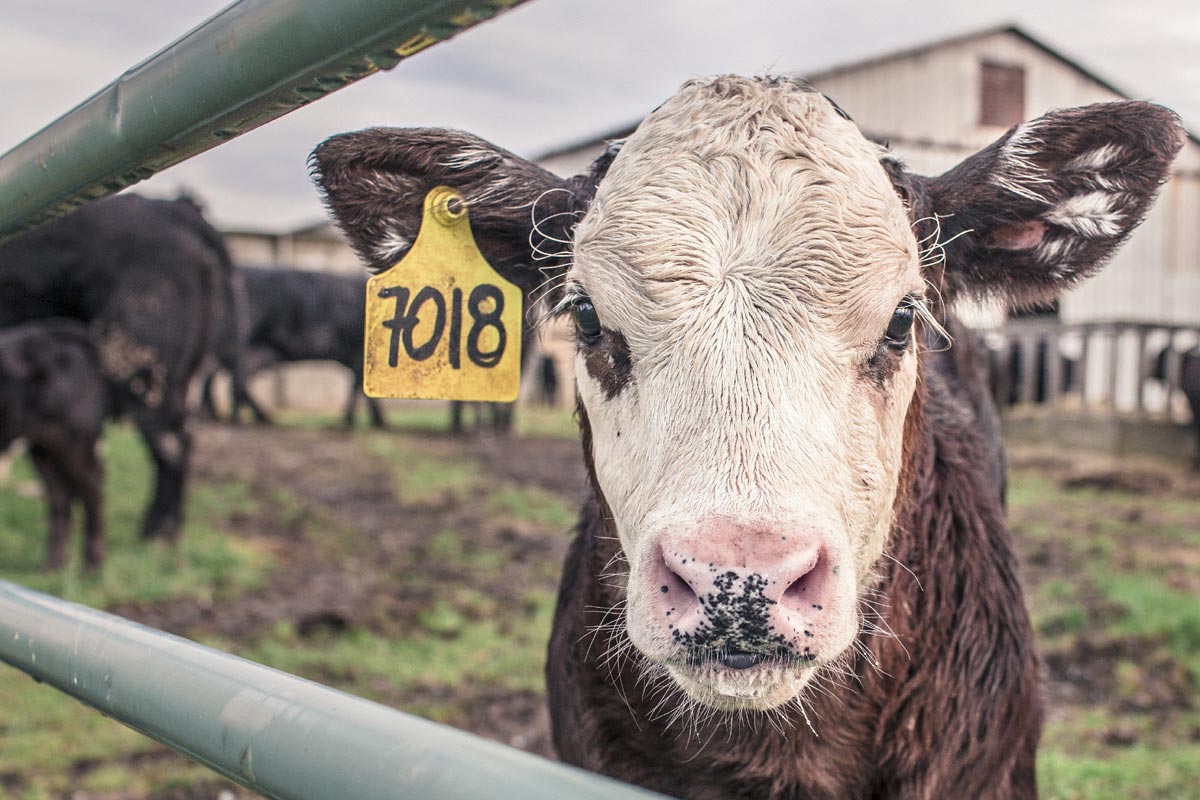“You must be the change you wish to see in the world” – Mahatma Gandhi
Humanity is over-exploiting the environment, driving global climate change, degrading ecosystems and causing biodiversity loss. Balancing the demands of a growing human population with ecological sustainability is becoming increasingly difficult.
Food production systems are under pressure and this in turn puts pressure on the environment. Scientists, ecologists and agriculturalists are constantly researching solutions to produce enough food for the growing population in an ecological sustainable way. But this is no longer a problem that can be solved by them alone.
This has become the problem of every human who is dependent on earth for their survival.
Livestock farming is responsible for 18% of greenhouse gas emissions
The world population reached the 7 billion between October 2011 (according to the United Nations Population Fund) and March 2012 (according to the United States Census Bureau, USCB). At the current population growth rate the world population is predicted to reach 7.5 to 8 billion by 2025, 11 billion by 2050 and a worst case scenario of 16 billion by 2100 1.
The production of food will have to more than double to feed this population adequately. Drastic changes are needed.
Firstly, we need to change our eating habits and secondly, in the type and production of food we eat. We will have to determine which farming practices will deliver the greatest production with the least impact on natural resources. We need to aid natural biological cycles by developing crops to deliver greater food return.
If we look at basic ecological principles, we can already guess which systems will be most efficient and sustainable. Primary producers (plants) comprise the first trophic level, followed by primary consumers (herbivores) and secondary consumers (carnivores) on the highest trophic level.
Energy is lost from one trophic level to the next. Only approximately 10% of the energy used in one level is available for the next level.
In this system the output of biomass will decrease from one level to the next since less energy is available when moving up to higher trophic levels. Therefore, there are fewer herbivores than plants and fewer carnivores than herbivores in a system. If we consider the numbers of the total human population, it makes no ecological sense for humans to occupy the highest trophic level.
A closer look at the true environmental footprint of meat production reveals that these food production systems are not sustainable in the long term.
Food production in general has a strong effect on the environment and is responsible for about 25% of global greenhouse-gas emissions 2, but within the agricultural sector, livestock farming has the largest environmental footprint.
Livestock farming is responsible for 18% of greenhouse gas emissions 3.
Overall beef generates 27.1 kilos of CO2 per kilo consumed 4. Because of the high volume of manure produced in intensive livestock farming it is also responsible for emitting 68% of anthropogenic nitrous oxide, which stays in the atmosphere for up to 150 years and has 296 times the global warming potential of carbon dioxide 5.
Livestock are also responsible for almost 64% of anthropogenic ammonia emissions, which contribute significantly to acid rain and acidification of ecosystems 6.
Cattle produced methane has 23 times the greenhouse gas impact of carbon dioxide, and a single cow can produce as much as 500 litres of methane per day. Intensive farm animal operations lead to increased methane emissions because of the animals’ diet. The reason for this is that animals in factory farms are given large amounts of concentrated, high-protein feeds causing them to generate 50% more methane emissions 7.

Relative to animal-based foods, plant-based foods have lower Greenhouse gases (GHG) emissions. Ruminant meats (beef and lamb) for instance have emissions per gram of protein that are about 250 times those of legumes 8. Agricultural emissions would be reduced by 1.2 – 2.3 gigatonnes of carbon-dioxide carbon equivalents per year (30-60% of the projected 2050 emissions from agriculture under the reference diet) if alternative plant based diets were adopted by the world’s population 9
Meat production, particularly factory farms, also has a huge environmental impact beyond climate change emissions. Meat takes up to ten times as much input, depending on the type of animal and the conditions in which they are raised, per unit of food as do grain, fruit and vegetables.
Animals in factory farms consume large amounts of feed grown on land that could grow food crops, bringing them into inevitable conflict with other potential uses for arable land and impacting on natural biodiversity.
The demand for feedgrains and other feed materials has greatly increased the arable land requirements of livestock production from a very small area to about 30% of the total arable land today 10 and FAO 2011 11 estimates that feed demand for grain will increase by nearly one billion tonnes over the 1997/99 to 2030 period.
The efficiency with which various animals convert grain into protein varies widely. With cattle, it takes roughly 7 kilograms of grain to produce 1 kilogram of beef, for pork, the figure is close to 4 kilograms of grain, and for poultry it is just over 2kg 12.
Converting land to fields used to feed animals grown for meat and milk results in deforestation, biodiversity losses, worsened soil erosion, and increased carbon emissions. Livestock-related activities, therefore contribute significantly to the ecological footprint, directly through land use and also indirectly through the area needed to absorb CO2 emissions (from fossil fuel use in livestock production).
Using large areas of land for animal feed can result in major biodiversity losses, such as those occurring in the Cerrado region in Brazil, the world’s most biologically diverse savannah 13.
At current trends, the ecological footprint of the livestock sector will increase due to expansion of land use and land degradation. The impact of this will only worsen with the increased demand for animal products per capita, the spread of intensive livestock farms, and population growth.
Cropland requirements would be reduced by 450 million to 600 million hectares (about 20-30% of the projected 2050 cropland area for the reference diet) if alternative plant based diets were adopted by the world’s population 14 .
What is even more difficult to swallow is the effect that meat production has on our scarce water resources. In an increasingly water-scarce world, different uses for freshwater necessarily compete with each other.
The desirability of reducing our carbon footprint is generally recognized, but the related and equally urgent need to reduce our water foot-print is often overlooked. Agriculture dominates global water use, dwarfing the next highest use, domestic water supply, by a factor of three 15.
Current industrialized livestock production, primarily through its dependence on crop-based feed, requires immense amounts of water and directly competes with other end users. Production of animal products accounts for 27% of the water footprint of humanity, while only 4% relates to water use at home 16.
A 200g beef hamburger can require 1000l of water to produce. This is roughly the equivalent of a month’s worth of showers! If you want to reduce your water footprint, you should consider your diet, in addition to water use in and around the home.
The global water footprint of animal production is 2 422 billion m3/year with one third of this total related to beef cattle, and 19% to dairy cattle 17.
The largest contribution to the total water footprint of all final animal products comes from growing the feed. The water footprint of any animal product is larger than the water footprint of a wisely chosen crop product with equivalent nutritional value.
The average water footprint per calorie for beef is 20 times larger than that for cereals and starchy roots. Per gram of protein for milk, eggs, and chicken it is about 1.5 times larger than for pulses.
On average 1kcal of animal product requires roughly 2.5 L of water, while products of vegetable origin with similar nutrition only 0.5 L of water/kcal 18. From these values it is obvious that consumers can reduce their water footprint by reducing their volume of meat consumption.
An additional problem with both intensive livestock farms and traditional livestock farming method is water pollution. The US Geological Survey shows that intensive livestock farms have a significant impact on water quality 19 .
Nutrients from livestock and poultry manure are key sources of water pollution caused by ever-growing numbers of livestock and poultry per farm and per acre in intensive livestock farms. In areas of high livestock density, the capacity of surrounding land or waters to absorb the waste is often exceeded and environmental damage is caused.
A great deal of energy and water is lost in the process of converting plant protein to animal protein while the direct use of plant protein is sufficient nutrition for humans. To be able to produce sustainable food for a growing population in future we will have to take these facts into account and adapt to alternative farming systems to ensure food security in future.
Applying ecologically-integrated structures and functions to food production systems to support a future with lower animal-product food demands would drastically reduce habitat and biodiversity loss, fossil fuel energy use, greenhouse gas emissions, and pollution while providing highly nutritious diets that greatly improve global human health.
The consumer, however, also needs to be informed on how his food is produced. We need to realize that everything we do has an impact on the planet and each individual has the power to decrease that impact.
As the plight of famine-stricken peasants gradually spreads to engulf us all, will we learn from the mistakes of the past in time to save humankind or will we continue to imagine that technology will save us from hunger this time?
References
- United Nations, 2004. World population to 2300, Report no: ST/ESA/SER.A/236, Department of Economic and Social Affairs, Population Division, United Nations, New York
- Vermeulen, S.J., Campbell, B.M. & Ingram, J.S.L. 2012. Climate change and food systems. Rev. Environ. Resour. 37. 195-222.
- http//www.fao.org/docrep/010/a0701e/a0701e00.htm.
- Hamerschlag, K & Venkat, K. 2011. A meat eater’s guide to climate change and health: What you eat matters. Lifecycle assessments (sic): Methodology & Results. Environmental working Group, Web, 10 Nov. 2011.
- http//www.fao.org/docrep/010/a0701e/a0701e00.htm.
- http://www.virualcentre.org/en/library/key_pub/longshad/A0701E00.htm
- http://www.epa.gov/climate change/emissions/downloads06/98CR.pdf
- Tilman, D. & M. Clark. 2014. Global diets link environmental sustainability and human health. 515. 518-522.
- Tilman, D. & M. Clark. 2014. Global diets link environmental sustainability and human health. 515. 518-522.
- Steinfeld, H. 2006. Livestock’s Long Shadow: Environmental Issues and Options, FAO, 2006
- http://faostat.fao.org
- Rosegrant, M.W., Leach, N. &. Gerpacio, R.W. 1999. Meat or wheat for the next millennium? Alternative futures for world cereal and meat consumption. Proceedings of the Nutrition Society. 219-234.
- http://assets.panda.org/downloads/factsheet_soy_eng.pdf
- Tilman, D. & M. Clark. 2014. Global diets link environmental sustainability and human health. 515. 518-522.
- Gleick, P.H. 2003. Water use. Rev. Env. Res. 28. 275-314.
- (Hoekstra, A.Y. 2012. The hidden water resource use behind meat and dairy. Animal Frontiers. 2 (2). 3-8.)
- Mekonnen, M.M. and Hoekstra, A.Y. 2010. The green, blue and grey water foot-print of farm animals and animal products. Value of Water Res. Rep. Ser. 48. UNESCO-IHE, Delft, the Netherlands.
- Hoekstra, A.Y. 2012. The hidden water resource use behind meat and dairy. Animal Frontiers. 2 (2). 3-8.
- ers.usda.gov/Amberswaves/Feb03/features/ManagingManure.htm



